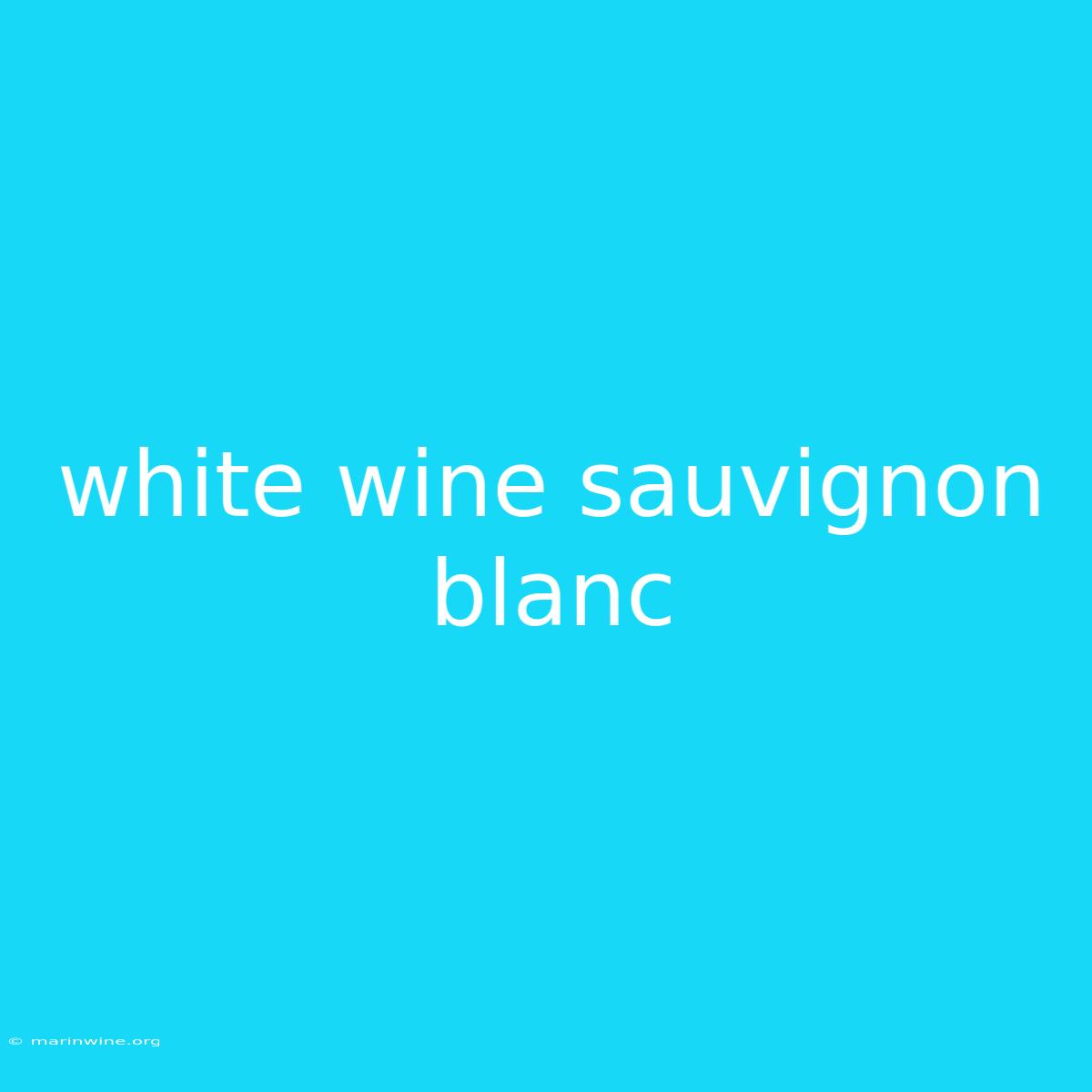Unveiling the Zesty Delight of Sauvignon Blanc: A Deep Dive into This Popular White Wine
Have you ever wondered what makes Sauvignon Blanc so captivating? This crisp, refreshing white wine is a global favorite, and for good reason. From its vibrant citrus flavors to its versatility, let's explore what makes Sauvignon Blanc a standout in the world of wines.
Why It Matters: Understanding Sauvignon Blanc can elevate your wine knowledge, enhance your tasting experiences, and guide you to new flavor discoveries. This article explores the unique characteristics of this popular grape, delving into its origins, flavor profiles, food pairings, and more.
Key Takeaways of Sauvignon Blanc:
| Feature | Description |
|---|---|
| Origin: | Primarily from the Bordeaux region of France, though now widely grown globally. |
| Flavor Profile: | Zesty citrus (lemon, lime, grapefruit), herbaceous notes (grass, gooseberry), and a hint of minerality. |
| Body: | Light to medium-bodied, with high acidity. |
| Versatility: | Pairs well with a wide range of dishes, from seafood to salads and cheeses. |
Sauvignon Blanc: A Journey from Vineyards to Glass
The Birth of a Zesty Classic
Sauvignon Blanc's origins trace back to the Bordeaux region of France, where it has been cultivated for centuries. Its name, derived from "sauvage" (wild) and "blanc" (white), hints at its wild, natural characteristics. Over time, the grape spread to other regions, gaining prominence in New Zealand, Chile, South Africa, and California.
Key Aspects of Sauvignon Blanc's Appeal
-
Intense Aromas: The fruit's high acidity and aromatic compounds contribute to a distinct aroma profile. This includes pronounced notes of citrus, passionfruit, and sometimes a touch of tropical fruit.
-
Herbaceous Undertones: The grape's unique composition often results in herbaceous notes like green bell pepper, grassy, or gooseberry, adding complexity and depth.
-
Mineral Influence: Some Sauvignon Blancs display a subtle minerality, hinting at the soil and terroir where the grapes are grown. This can be expressed as a flinty or chalky undertone.
-
Varietal Expression: Sauvignon Blanc exhibits significant variation depending on the growing region. New Zealand wines are known for their intense tropical fruit flavors, while French examples tend to be more herbaceous and minerally.
The Impact of Climate and Terroir
Climate and terroir play a significant role in shaping the final taste of Sauvignon Blanc. Warmer climates, like those in California, often yield fuller-bodied wines with more pronounced tropical fruit flavors. Cooler climates, like those of New Zealand and parts of France, result in wines with greater acidity and herbaceousness.
Beyond the Grape: Food Pairings and Enjoyment
Discovering the Perfect Match
Sauvignon Blanc's crisp acidity and vibrant flavors make it an excellent complement to a variety of dishes:
-
Seafood: The wine's acidity cuts through the richness of fatty fish like salmon or tuna, while its zesty notes enhance shellfish like oysters and mussels.
-
Salads and Appetizers: Its refreshing character pairs well with light salads, particularly those with citrus dressings. It also pairs beautifully with cheese boards featuring goat cheese, brie, or fresh cheeses.
-
Asian Cuisine: Sauvignon Blanc's acidity and herbaceousness complement the spice and aromatics of Asian dishes, including stir-fries and sushi.
Tips for Enjoying Sauvignon Blanc
-
Serve Chilled: Sauvignon Blanc is best enjoyed chilled, between 45-50°F, to enhance its crispness and refreshing qualities.
-
Choose a Glass: Use a white wine glass with a wide bowl to allow the aromas to fully develop.
-
Consider the Year: Sauvignon Blanc is generally best enjoyed young, within a few years of vintage.
FAQs: Unraveling Common Questions
Q: How can I tell if a Sauvignon Blanc is good quality?
A: Look for wines with a bright, clear color, vibrant aromas, and a balanced taste profile. A good Sauvignon Blanc will have a crisp acidity that doesn't feel overly tart or harsh.
Q: What are the best food pairings for Sauvignon Blanc?
A: Seafood, salads, and Asian cuisine are ideal pairings. The wine's acidity balances rich flavors while its zesty notes enhance the dish.
Q: Is Sauvignon Blanc a good wine for beginners?
A: Yes, Sauvignon Blanc is a great choice for newcomers to wine. Its refreshing flavors and versatility make it approachable and enjoyable.
Q: Is Sauvignon Blanc a sweet wine?
A: No, Sauvignon Blanc is not a sweet wine. It is typically dry, with a high acidity that contributes to its crispness and refreshing character.
Tips for Selecting Sauvignon Blanc
-
Region: Explore different regions, like New Zealand, France, or California, to discover diverse flavor profiles.
-
Tasting Notes: Pay attention to tasting notes on the bottle, which can offer insight into the wine's character and flavors.
-
Price Point: Don't be afraid to try wines at different price points to find your favorite.
Summary by Sauvignon Blanc
This exploration of Sauvignon Blanc has unveiled its unique appeal, from its captivating aroma profile to its diverse flavor expressions. This versatile white wine offers a refreshing experience, perfect for casual gatherings or sophisticated dinners. Embrace the zesty delight of Sauvignon Blanc and discover the world of flavors it holds.
Closing Message: The next time you're looking for a crisp, refreshing white wine, consider Sauvignon Blanc. Explore its diverse offerings and find your perfect match for a truly enjoyable experience.

